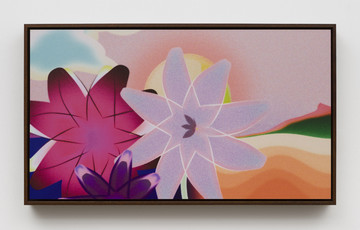Foxy Production is proud to present Erin Calla Watson and Travess Smalley, two artists who are pushing digital art into new territories.
Travess Smalley’s vivid new video is auto-generated by his LandscapeScript computer program that gives instructions to Adobe Photoshop to produce landscapes. These scenes can potentially include multiple celestial objects, clouds, flower types, mountains, and terrains. Smalley uses both high and low tech means to move drawing, painting, collage, and sculpture in and out of the digital realm. He is vitally interested in how codes and systems can construct, transfer, and disrupt images.
“The book The Algorithmic Beauty of Plants by Aristid Lindenmayer and Przemysław Prusinkiewicz goes into a lot of the math around the things we experience in nature. In programming—or at least in the way I do it—if you want to make a flower, you look at photos of flowers and ask yourself how it can be generated. Then you come up with all this math and realize it can’t all just be geometric forms. You have to give it some natural qualities and textures. Bruno Munari’s Drawing a Tree is also an amazing resource for these sorts of creative coding projects.
As I mentioned before, I’m working on a procedurally generated landscape program that’s inspired by the work of landscape painters like Arthur Dove and Charles Burchfield.
It’s all done through scripting, and I’ve been looking at the history of how artists, scientists, naturalists, programmers, and even preachers have thought about the idea of making their own flower. One of my largest channels on are.na is called “To Make a Flower,” and includes all of my research.
This project is the richest of the generative programs I’ve made in terms of its complexity and the type of outputs that I’m getting from it. I’ve been working on it for two years and have the same question about how I’ll decide when it’s finished. As an artist, that’s one question I’m always asking and rarely answering. A great way to reconcile that for me is to think about the photographic tradition of the contact sheet, where you make 35 images or more, but you’re still picking the best one. I’m in that space right now where I’m rendering out a hundred results, picking the best ones, and tweaking the script.”
Travess Smalley extracts from “Conversations: JOHN PROVENCHER & TRAVESS SMALLEY in Outland, April 12, 2022, online.
Travess Smalley (Huntington, WV, 1986) lives and works in Providence, RI. He holds a BFA from The Cooper Union, New York, NY, and an MFA from the Rhode Island School of Design, Providence, RI. Exhibitions include: “Des champs de fraises pour l’éternité,” La Galerie, centre d’art contemporain de Noisy-le-Sec, Noisy-le-Sec, France (2022); “Minecraft Language Edition,” Ender Gallery in collaboration with MacKenzie Art Gallery, Regina, SK, Canada (solo)(2021); “Pixel Rugs,” Arcade On Stadium, Provo, UT (solo)(2021); “Downtown Painting,” Peter Freeman Inc., New York, NY (2019); and “Standing Still, Lying Down, As If,” Museum of Contemporary Art Detroit, Detroit, MI (2018-2019).

Erin Calla Watson’s new photographs channel a long tradition in the fields of visual art, literature, psychoanalysis, and philosophy, among others, where rooms are activated with a psycho-sexual charge, including the dark interiors of Dutch Golden Age paintings of licentious taverns; Virginia Woolf’s notion of a room being essential for a woman’s autonomy; and Walter Benjamin’s characterization of “the phantasmagoria of the interior,” the individual’s universe of illusion, their protection from the outside world.
Benjamin’s description of the interior and its obverse, the harsh exterior world of work and conformity, has a direct line to the recent writings of Lauren Berlant and Sianne Ngai on how feelings are embedded in our personal aesthetics, and what the political consequences of this process are. Calla Watson’s new series of photographs highlights and disrupts this weaponizing of affect by appropriating private spaces shared on online manosphere platforms and pushing them through prisms of visual modification, including inserting popular cultural icons that are replete with sentiment, angst, and trauma: Bambi, for instance, is a central signifier of the destruction of childhood innocence when his mother is “murdered” by a hunter; Britney Spears, here holding a snake aloft, represents a sensual ingenue trapped in a legal straitjacket instituted by her malevolent father; and the sinister Frank character from Donnie Darko embodies the disturbed mind of the film’s protagonist.
The artist based her new works on a photograph showing an untidy and seemingly adolescent bedroom where items are strewn about. The person sharing the image online may have meant it as a parody of the single men who usually post well-designed, if formulaic, contemporary rooms, but as Calla Watson has stated: “it’s equally as likely that the original image was posted sincerely…I chose the room for its ambiguity.” The space’s messiness and nebulosity as well as the transformations and cultural interventions performed upon it by the artist suggest we are witnessing a dreamscape where the repressed is expressed, or we are watching a screen where memories, reliable or unreliable, float across the surface. Not unlike Mike Kelley’s Educational Complex, his monochrome miniatures of every school he ever attended, Calla Watson’s photographs can be seen as architectural models, imbued with emotive psychic resonances, that act as fissures in the social armature of convention and control.
Erin Calla Watson (Los Angeles, CA, 1993) lives and works in Los Angeles, CA. Calla Watson received a BFA from Otis College of Art and Design, Los Angeles. Exhibitions include “Erin Calla Watson,” Foxy Production, New York (forthcoming 2023); “a somewhat thin line,” In Lieu, Los Angeles, CA; “KYLE,” Larder, Los Angeles (both 2022); and “The Conspiracy of Art: Part II,” Chateau Shatto, Los Angeles (2019).







